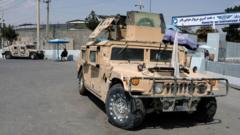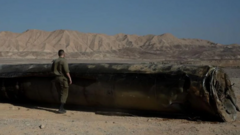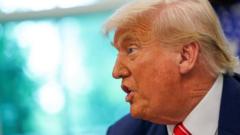Following the Taliban's takeover of Afghanistan, an alarming number of US-supplied weapons have gone missing or entered the black market, with accusations of affiliations to militant groups. Despite Taliban assurances of secure storage, evidence suggests a thriving arms trade and unaccounted military equipment, raising significant concerns for regional security.
US Weapons in Afghanistan: A Growing Concern of Militancy and Smuggling

US Weapons in Afghanistan: A Growing Concern of Militancy and Smuggling
Reports detail how half a million US weapons left in Afghanistan have been lost, sold, or smuggled, posing serious risks as they potentially support militant groups including al-Qaeda.
Article:
In 2021, following the Taliban's resurgence in Afghanistan, a staggering half a million weapons became unaccounted for, with reports suggesting they have been sold or smuggled to various militant groups. This alarming information, conveyed by sources to the BBC, also indicates that weapons have made their way into the hands of al-Qaeda affiliates.
The Taliban seized control of nearly a million pieces of military equipment, largely funded by US resources, as they advanced through Afghanistan. Many Afghan soldiers fled or surrendered, leaving behind their weapons and vehicles, and US forces also abandoned significant amounts of military technology. The collection included American-made firearms such as M4 and M16 rifles, along with other older weaponry collected over decades of conflict.
According to sources who attended a private UN Security Council Sanctions Committee meeting, the Taliban confessed that a considerable portion of these weapons—specifically, half a million items—are currently "unaccounted" for. Verification from independent sources backs this claim, highlighting the troubling unknown fate of these weapons. A UN report from February revealed that al-Qaeda affiliates—including groups such as Tehreek-e-Taliban Pakistan and the Islamic Movement of Uzbekistan—are either acquiring these weapons from the Taliban or purchasing them on the black market.
In response to the BBC's inquiries, Hamdullah Fitrat, deputy spokesperson for the Taliban government, categorically denied claims of smuggling and losses, stating that they take weapon storage very seriously. However, a 2023 UN report reveals that local Taliban commanders have permission to keep 20% of the seized US weapons, further bolstering black market activities.
The arms trade has evolved to become a significant concern; a former journalist from Kandahar noted that an open arms market flourished shortly after the Taliban takeover, although it has since transitioned to an underground operation using messaging platforms like WhatsApp. This platform facilitates trade in US weapons and military gear among wealthy individuals and local commanders, many of whom are instrumental in the opulent black-market transactions.
The Special Inspector General for Afghanistan Reconstruction (SIGAR) has reported that the actual number of weapons left behind by US forces is lower than estimates presented by various sources. They struggled to obtain precise information due to a complex tracking system, impacted by years of inadequate communication from the Department of Defense and the State Department. SIGAR criticized the latter for providing "limited, inaccurate, and untimely" information regarding the equipment's status.
This issue transcends mere military concerns; it is deeply political. Former US President Donald Trump asserted his intention to reclaim abandoned weapons in Afghanistan, stating that $85 billion worth of military equipment was irresponsibly left behind. Trump claimed that Afghanistan has become a leading arms seller due to the US military equipment they are peddling.
In stark contrast, Taliban spokesperson Zabihullah Mujahid declared that they had rightfully seized these weapons from prior officials and would use them to defend their nation against threats. Equipped with US weaponry, the Taliban have gained considerable military advantage, overshadowing rival factions such as the National Resistance Front and ISIS Khorasan Province.
While the Taliban have paraded captured US weapons, showcasing them in propaganda campaigns, their proficiency in operating advanced machinery remains questionable. Challenges persist in maintaining sophisticated equipment like Black Hawk helicopters, largely attributed to a lack of necessary technical expertise.
With concerns rising regarding the proliferation of military weapons and their potential misuse by militant groups, John Sopko, former head of SIGAR, remarked that any attempt to reclaim these arms may be futile given their diminished value and the practical challenges involved. What actions, if any, will emerge from these assessments remains to be seen, but the security landscape continues to evolve amid the widespread dispersal of military hardware in the region.
In 2021, following the Taliban's resurgence in Afghanistan, a staggering half a million weapons became unaccounted for, with reports suggesting they have been sold or smuggled to various militant groups. This alarming information, conveyed by sources to the BBC, also indicates that weapons have made their way into the hands of al-Qaeda affiliates.
The Taliban seized control of nearly a million pieces of military equipment, largely funded by US resources, as they advanced through Afghanistan. Many Afghan soldiers fled or surrendered, leaving behind their weapons and vehicles, and US forces also abandoned significant amounts of military technology. The collection included American-made firearms such as M4 and M16 rifles, along with other older weaponry collected over decades of conflict.
According to sources who attended a private UN Security Council Sanctions Committee meeting, the Taliban confessed that a considerable portion of these weapons—specifically, half a million items—are currently "unaccounted" for. Verification from independent sources backs this claim, highlighting the troubling unknown fate of these weapons. A UN report from February revealed that al-Qaeda affiliates—including groups such as Tehreek-e-Taliban Pakistan and the Islamic Movement of Uzbekistan—are either acquiring these weapons from the Taliban or purchasing them on the black market.
In response to the BBC's inquiries, Hamdullah Fitrat, deputy spokesperson for the Taliban government, categorically denied claims of smuggling and losses, stating that they take weapon storage very seriously. However, a 2023 UN report reveals that local Taliban commanders have permission to keep 20% of the seized US weapons, further bolstering black market activities.
The arms trade has evolved to become a significant concern; a former journalist from Kandahar noted that an open arms market flourished shortly after the Taliban takeover, although it has since transitioned to an underground operation using messaging platforms like WhatsApp. This platform facilitates trade in US weapons and military gear among wealthy individuals and local commanders, many of whom are instrumental in the opulent black-market transactions.
The Special Inspector General for Afghanistan Reconstruction (SIGAR) has reported that the actual number of weapons left behind by US forces is lower than estimates presented by various sources. They struggled to obtain precise information due to a complex tracking system, impacted by years of inadequate communication from the Department of Defense and the State Department. SIGAR criticized the latter for providing "limited, inaccurate, and untimely" information regarding the equipment's status.
This issue transcends mere military concerns; it is deeply political. Former US President Donald Trump asserted his intention to reclaim abandoned weapons in Afghanistan, stating that $85 billion worth of military equipment was irresponsibly left behind. Trump claimed that Afghanistan has become a leading arms seller due to the US military equipment they are peddling.
In stark contrast, Taliban spokesperson Zabihullah Mujahid declared that they had rightfully seized these weapons from prior officials and would use them to defend their nation against threats. Equipped with US weaponry, the Taliban have gained considerable military advantage, overshadowing rival factions such as the National Resistance Front and ISIS Khorasan Province.
While the Taliban have paraded captured US weapons, showcasing them in propaganda campaigns, their proficiency in operating advanced machinery remains questionable. Challenges persist in maintaining sophisticated equipment like Black Hawk helicopters, largely attributed to a lack of necessary technical expertise.
With concerns rising regarding the proliferation of military weapons and their potential misuse by militant groups, John Sopko, former head of SIGAR, remarked that any attempt to reclaim these arms may be futile given their diminished value and the practical challenges involved. What actions, if any, will emerge from these assessments remains to be seen, but the security landscape continues to evolve amid the widespread dispersal of military hardware in the region.





















